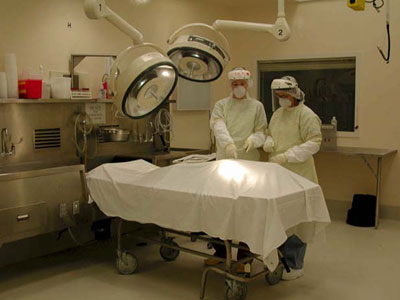An autopsy is the examination of dead bodies through surgical operations. Autopsies can be used to identify time of death, cause of death, habits and health of the victim, and much more. There can be some controversy over the use of autopsy. It is not uncommon for families to wish to preserve the bodies of their deceased member, but in some cases, the government can demand that an autopsy be done. Religions, too, have an opinion in whether or not autopsies should be allowed on people of the belief. Every medical examiner has the right to refuse to do an autopsy. (Citation 8)
| Autopsy lab. (Image 11) |
After the initial examination, medical examiners take the bodies into their lab and look deeper. They dissect the body and look for signs of anything unusual, like foreign materials in the hair or mouth. They examine organs and send samples to labs to identify chemical levels within the body. Here they can determine the exact cause of death and the victim's health history and provide much information for the case.
Home | History | Innovators | Crime Scene Analysis | DNA Testing | Toxicology | Criminalistics | Autopsy | Citations
